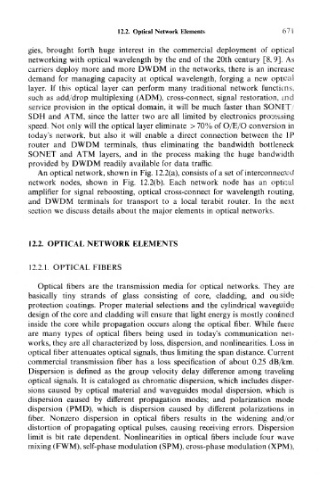Page 687 - Introduction to Information Optics
P. 687
12.2. Optical Network Elements 67 I
gies, brought forth huge interest in the commercial deployment of optical
networking with optical wavelength by the end of the 20th century [8,9]. As
carriers deploy more and more DWDM in the networks, there is an increase
demand for managing capacity at optical wavelength, forging a new optical
layer. If this optical layer can perform many traditional network functions,
such as add/drop multiplexing (ADM), cross-connect, signal restoration, and
service provision in the optical domain, it will be much faster than SONET/
SDH and ATM, since the latter two are all limited by electronics processing
speed. Not only will the optical layer eliminate > 70% of O/E/O conversion in
today's network, but also it will enable a direct connection between the IP
router and DWDM terminals, thus eliminating the bandwidth bottleneck
SONET and ATM layers, and in the process making the huge bandwidth
provided by DWDM readily available for data traffic.
An optical network, shown in Fig. 12.2(a), consists of a set of interconnected
network nodes, shown in Fig. 12.2(b). Each network node has an optical
amplifier for signal reboosting, optical cross-connect for wavelength routing,
and DWDM terminals for transport to a local terabit router. In the next
section we discuss details about the major elements in optical networks.
12.2. OPTICAL NETWORK ELEMENTS
12.2.1. OPTICAL FIBERS
Optical fibers are the transmission media for optical networks. They are
basically tiny strands of glass consisting of core, cladding, and outside
protection coatings. Proper material selections and the cylindrical waveguide
design of the core and cladding will ensure that light energy is mostly confined
inside the core while propagation occurs along the optical fiber. While there
are many types of optical fibers being used in today's communication net-
works, they are all characterized by loss, dispersion, and nonlinearities. Loss in
optical fiber attenuates optical signals, thus limiting the span distance. Current
commercial transmission fiber has a loss specification of about 0.25 dB/km.
Dispersion is defined as the group velocity delay difference among traveling
optical signals. It is cataloged as chromatic dispersion, which includes disper-
sions caused by optical material and waveguides modal dispersion, which is
dispersion caused by different propagation modes; and polarization mode
dispersion (PMD), which is dispersion caused by different polarizations in
fiber. Nonzero dispersion in optical fibers results in the widening and/or
distortion of propagating optical pulses, causing receiving errors. Dispersion
limit is bit rate dependent. Nonlinearities in optical fibers include four wave
mixing (FWM), self-phase modulation (SPM), cross-phase modulation (XPM),

